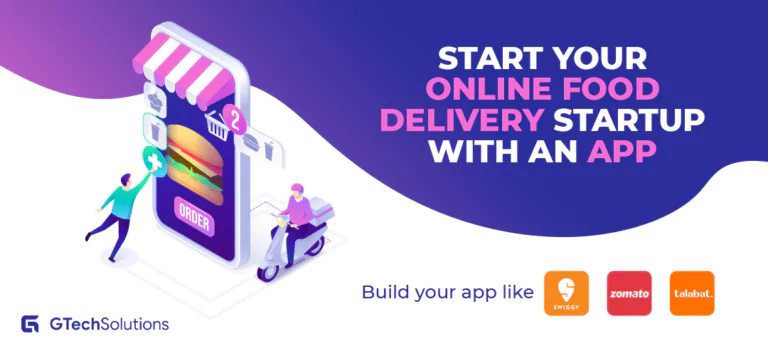Mobile App Development Process


Mobile apps are “da bomb” these days. This is because mobile apps can be used anywhere and anytime as they are installed on light-weight and portable smartphones unlike websites that are usually accessed via desktops or laptops which are not as portable as smartphones. Mobile apps are used by people for a wide array of purposes. Prominent among them are on-demand delivery apps to meet daily requirements. That being the case, you might be curious to know about the processes involved in mobile app development process . If so, kindly read on because that’s exactly what we’re going to discuss in this blog post.
Table Of Contents
Growth Of Mobile Apps- The Detailed Process
The Growth Of Mobile Apps The Detailed Process Of Developing An App
Mobile apps have witnessed an exponential increase in their usage worldwide ever since the smartphone technology started rapidly advancing since the beginning of 2014. Mobile apps had about 1.4 trillion users in 2016.
That number grew to 2.18 trillion by the end of 2020. The projected rise in the number of app users worldwide is 2.58 trillion by the end of this year (2022). That’s a whopping 83% increase in user base in just six years!
Research has shown that the average person spends about 3 hours and 10 minutes everyday checking his smartphone. Out of that time, 2 hours and 51 minutes are spent on browsing apps. Netizens on the other hand check their smartphones and apps every 10 minutes! This just goes to show how smartphones and mobile apps have become an integral part of our lives.
Mobile apps greatly benefit businesses too. The revenue that businesses got from mobile apps during 2014 was USD 97.7 billion. That number increased exponentially to USD 5.82 trillion by the end of 2020. Then it swelled to USD 6.93 trillion by the end of 2021. The revenue from mobile apps is expected to balloon to USD 8.1 trillion by the end of this year (2022) and USD 9.35 trillion by the end of 2023.
Clearly, both people and businesses benefit a lot from mobile apps. That’s the reason many firms have taken their businesses online by building their official apps and websites.
If you want to be a part of this success story by building a top-notch mobile app for your business, all you have to do is get in touch with us and we’ll take it from there.
The usage of mobile apps and the revenue and profits derived from them is only expected to grow exponentially in the coming decade. So, don’t miss out on this wonderful opportunity.
The Effective Mobile App Development Process Steps
The ultimate objective of developing a mobile app is to satisfy the business requirements of the client. Hence, attention has to be paid to every small detail stated by the client. Consequently, the app development process is elaborate yet efficient and free of flaws. The app development process is as stated below.
Requirement Analysis
In this phase of the app development process, the client’s requirements are analyzed thoroughly and the plan to design the app accordingly is made. Major tasks like:
- Analyzing and understanding the target audience’s demands from the app is done.
- The noteworthy features that competitors’ apps have is noted and if possible those features and useful additional features are incorporated into the app.
- All the features and functionalities that the app will have are decided.
- The coding technology or the SDK platform used to design the app is decided.
Apps can be classified into two types namely native apps and hybrid apps. Since there are only two major mobile OS platforms in the world namely iOS and Android, native apps belong to these two mobile OS platforms.
Native android apps are either coded in Kotlin or Java. Native iOS apps are coded in the Swift programming language which was recently developed by Apple in 2014.There are three major SDKs used to develop hybrid apps i.e., apps that can run on Android and iOS with minimal alterations to their source code. They are Flutter, Xamarin, and React Native.
The Flutter SDK uses the Dart coding technology to design cross-platform apps. Xamarin uses the C#.net programming language to design hybrid apps and the React Native SDK uses HTML 5 and Javascript coding technologies to design hybrid apps.
Designing A Wireframe For The App
A wireframe is a low-fidelity outlay of the app. It gives a fair idea of what the app is going to look like, what will be the options present on the app, how will the information be displayed on the app, etcetera. After frequent consultations with the client, the wireframe of the app is refined until the ultimate high-fidelity variant of it is produced.
Based on this high-fidelity wireframe of the app, the roadmap for the app’s development is built. The roadmap for the app development dictates the order of the construction of app features and filling of information on the app.
One must analyze the concerned app store/s and ensure that the name decided for the app isn’t already in use lest it’ll become a copyright issue.
Designing The UI/UX Of The App
The appeal of an app’s UI/UX will have an impact on user engagement and retention. Therefore, the UI/UX of an app has to be sophisticated yet easy to navigate.
Workflow diagrams help app developers analyze and correct if necessary all the possible scenarios when users interact with the app. This is done to provide app users a seamless and smooth experience when interacting with the app.
Coding The App
The coding of the app has to be done in accordance with the high-fidelity wireframe of the app developed earlier in the app design process. Every required feature and functionality of the app has to be tested thoroughly once developed to maintain the functional integrity of the app. Only the most suitable coding technology has to be employed to code the app to produce the best and the most appropriate app.
Coding the app mainly involves three main phases. They are: designing the UI/UX of the app, designing an API for the app to enable communication between the server and the app, and coding the backend functionalities of the app to enable flawless interaction between users and the app
Testing The App
The app once designed should be tested in all the important parameters. The app’s UI/UX should be tested to see if it is appealing and gives a great user interaction experience.
All the required functionalities of the app should be tested thoroughly to safeguard the functional integrity of the app. The app should function swiftly, seamlessly, and securely to give an enjoyable user experience. If the app is a hybrid app, then it should function swiftly and seamlessly in both the Android and iOS mobile OS platforms.
The more thoroughly the app is tested, the more its functional integrity will be maintained, the more content your client will feel, and the more downloads, ratings, and positive reviews the app will get.
Deployment And Support
While deploying the app on the appropriate app store, developers should ensure the following things:
Once the app is appropriately deployed on the suitable app store or both the app stores (Play Store and The App Store) in case of hybrid apps, appropriate ASO (App Store Optimization) techniques need to be applied on the app to make it rank on app store searches.
Even high quality Social Media Marketing (SMM) techniques and practices can be applied to make the app popular among the business’s target audience and to enhance app downloads.
Last but not least, the app has to be maintained (checking for runtime bugs and correcting them) and updated (if required) to maintain the user experience (UX) of the app and the user base of the client company.
The mobile app development process cost is not a fixed entity but a variable one. It depends on a multitude of factors like the number and complexity of the desired features, the experience and expertise of the app development team, the nationality of the app developers, and the coding technology and SDK used.
Generally speaking, developing an on-demand delivery app can cost anywhere between USD 6,000 to USD 40,000/-.
What is the growth of app development in India?
App Revenue Growth in India. From the above graph, we find that app revenue in India grew by 17.8% in 2018, and 23.2% in 2019. In 2020, the revenue growth crossed 68.2%. This count dropped to 32.6% in 2021, 18.2% in 2022, and is about to drop to 13.1% in 2023.
Where Do We Fit Into The Picture?
if you need a hi-tech mobile app for your business like beauty industries, food applications, cab booking, hospital sector, etc. to take it to the next level, simply get in touch with us and we’ll design you the most advanced and suitable app for your business. We have quite a few years of proven experience in the app development domain. Our app development portfolio and jubilant client reviews speak volumes about our technical expertise and professionalism.
We employ the latest app coding technologies and internationally recognized app development practices to design the best-in-class apps for our clients. We also offer other essential professional services like ASO, SMM, and app maintenance services to provide all round app development services to our clients. So, you’ll definitely get value for your money if you get in touch with us.
Conclusion
In conclusion, mobile app development process is a dynamic and intricate process that requires a collaborative effort and a user-centric approach. The success of an app hinges on a well-defined idea, efficient execution, thorough testing, and continuous improvement. Adapting to technological advancements and user feedback ensures that the app remains competitive and valuable in the ever-evolving mobile landscape.

The Author
Gopinath Murugaiyan
Managing Director




